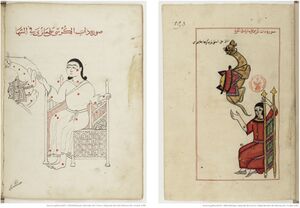An-nāqa (الناقة)
An-naqa

الناقة, al-Nāqa or an-naqa, The She-Camel, is an Arabic/ Arabian asterism.
Etymology and History
al-TERM in Adams (2018),[1] pp. xx-xx.
al-Nāqa per Khalid AlAjaji
Al-Nāqa was described in al-Anwaʾ books and by al-Ṣufī in his Book of Stars. Ibn Qutayba and al-Marzūqī have similar accounts, while al-Ṣufī gives a detailed precise description.
Al-Marzūqī said:
Behind al-Ridf in the Milky way is al-Kaff al-Ḫaḍīb of al-Ṯurayyā (the Henna dyed hand of al-Ṯurayyā), characterized by five bright stars that are not aligned. These stars are also considered the hump of a she-camel, likened to a finely bred, slender camel with a narrow nose. Its muzzle points southward, and its neck consists of a series of stars, descending from the head like a neck and then rising towards the hump. Additionally, there is a cloudy patch on the thigh, often referred to as the brand of the she-camel, which corresponds to Miʿṣam al-Ṯurayyā (the wrist of al-Ṯurayyā).
Ibn Qutayba had a similar account.
Al-Ṣufī have a precise outline of al-Nāqa. Here is his detailed description:
One of the prominent stars among the five stars of al-Kaff al-Ḫaḍīb is the 12th star [of Cassiopeia], located in the center of the back cushion. This star is marked on the astrolabe and referred to as al-Kaff al-Ḫaḍīb; it is also known as Sanām al-Nāqa (the Hump of the Camel), due to three preceding stars, situated on the right hand of the Chained Woman, Andromeda as named by Ptolemy. These three stars were mentioned by Ptolemy among the strars of Andromeda [the 7th, 8th, and 9th (ι, κ, λ Andromedae)].
Adjacent to the northernmost of these three stars lies another star that, together with the others, forms the head of the Camel. A sequence of smaller, faint stars connects this star to the bright one in the center of the back cushion, beginning near the hump and extending down to the mid-neck before ascending again to link with the head. This arrangement resembles a slender, fine bred camel with a thin neck and small head.
The first star at the head of the seated Woman (ζ Cas) marks the beginning of the camel's neck. The set of three body stars that connect to the head of Cassiopeia (α, η, γ) are at the base of the hump. The 12th star on the middle of the back cushion (β Cas), is positioned at the top of the hump. The sixth star of the seated Woman's leg (ε Cas) is on the rump, near the root of the tail. Beneath this sixth star and the fifth star from the knee is a small cloudy patch located in the hand of the One who grasps the head of al-Ġūl (Perseus), symbolizing the brand on the thigh of the she-camel.
Two additional stars on the right leg of the Chained Woman (51, 54 And) correspond to the two front legs of the she-camel, thus completing its resemblance. Ptolemy did not document the stars on the neck nor those forming the she-camel's body.
al-Nāqa in Laffitte (2012[2], 2025[3]).
Laffitte's identification is also available on his website.[4]
| Arabic | Arabic transliteration | English | author | identified stars |
|---|---|---|---|---|
| الناقة | al-Nāqa | the She-camel | Qutayba | figure |
| Ra’s al-Nāqa | the Head of the She-camel | Ṣūfī, Ast. | ικλ And | |
| Fum al-Nāqa | the Mouth the She-camel | Māğid | ικ And | |
| Ḥalq al-Nāqa | the Throat the She-camel | Māğid | β And ( ?) | |
| ᶜUnq al-Nāqa | the Neck the She-camel | Māğid | ζ Cas | |
| Naḥr al-Nāqa | the Sloudler Blade ofthe She-camel | Ḏ. hay. | ζ Cas ( ?) | |
|
the Back the She-camel
the Root of the Hump |
Ṣūfī | αγδ Cas | |
| al-Š(a)dād | the Saddle | St. Ajaji | βαγδ ε Cas | |
| Sanām al-Nāqa | the Hump the She-camel | Ṣūfī | β Cas | |
| Ṭaraf al-Sanām | the Top of the Hump | Ṣūfī | β Cas | |
| Baṭn al-Nāqa | the Billy of the She-camel | Māğid | δε Cas | |
| Kifal al-Nāqa | the Buttock of the She-camel | Ṣūfī | ε Cas | |
| Aṣl Ḏanab al-Nāqa | the Root of the Tail of the She-camel | Ṣūfī | ε Cas | |
| Sima ᶜalā Faḫiḏ al-Nāqa | the Brand on the Thigh of the She-c. | Māğid | χh Per | |
| Yad al-Nāqa | the Hand of the She-camel | Ṣūfī | φυ Per |
Discussion
IAU Working Group Star Names
Weblinks
Reference
Ibn Qutayba al-Dīnawarī, Abū Muḥammad ʿAbdallah b. Muslim. 1956. Kitāb al-anwāʾ (fī mawāsim al-ʿArab). Hyderabad: Maṭbaʿat Majlis Dāʾirat al-Maʿārif al-ʿUthmāniyya.
Al-Marzūqī, Abū ʿAli Aḥmad b. Muḥammad b. al-Ḥassan (died 1030), Al-Azminah wa al-Amkinah (Times and Places), (Arabic print of the original book in 2002, World of Books, Beirut, Lebanon)., الإمام أبو علي أحمد بن محمد بن الحسن المرزوقي (توفي سنة 421 هـ)، الأزمنة والأمكنة، تحقيق د. محمد نايف الدليمي، عالم الكتب، بيروت، لبنان، 1422 هـ.
Kunitzsch, Paul. 1961. Untersuchungen zur Sternnomenklatur der Araber. Wiesbaden: Otto Harrassowitz.
al-Ṣūfī, Abū al-Ḥusayn ʿAbd al-Raḥmān b. ʿUmar. 1981. Kitāb ṣuwar al-kawākib al-thamāniya wa al-arbaʿīn. Beirut: Dār al-Āfāq al-Jadīda.
- ↑ Danielle Adams, Rain Stars Set, Lunar Stations Rise, 2018
- ↑ Roland Laffitte, Le ciel des Arabes, 2012
- ↑ Roland Laffitte, Nommer les étoile: 500 noms hérités des Arabes - Apport de l'uranographie arabe, Orient des Mots, 2025 (online)
- ↑ Laffitte: URANOS.FR https://uranos.fr/wp-content/uploads/2025/01/CATALOGUE_EN_03_01_25_LITE.pdf


